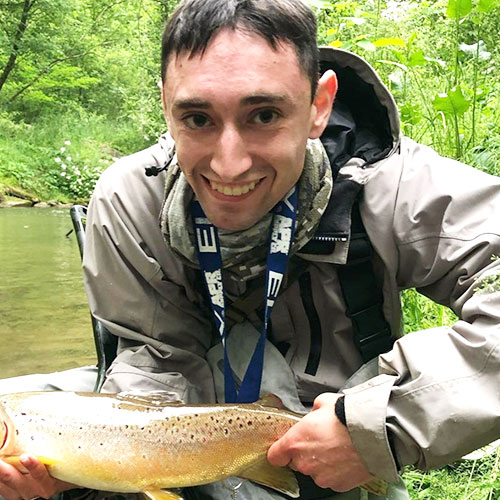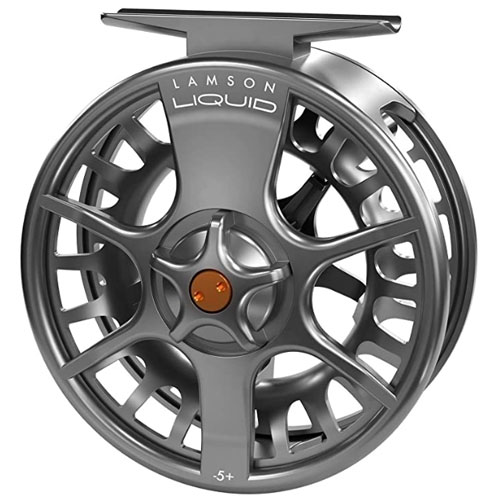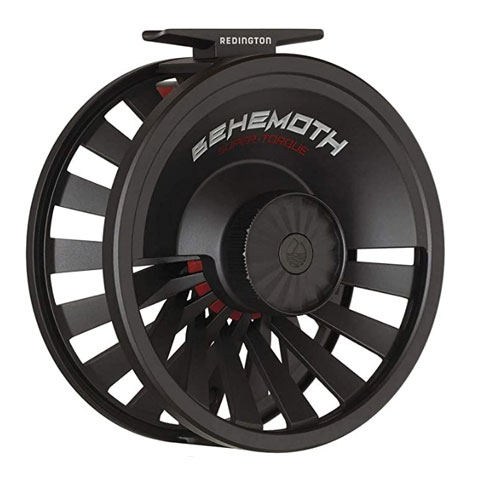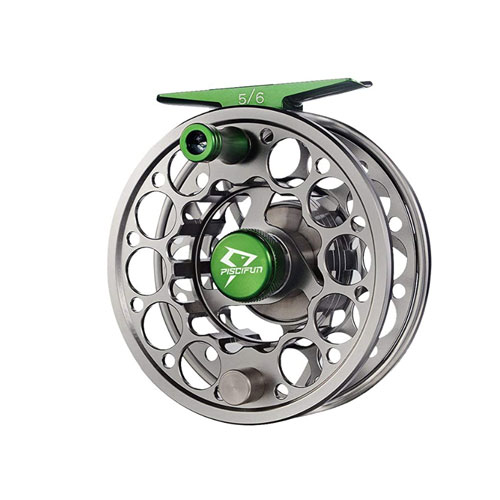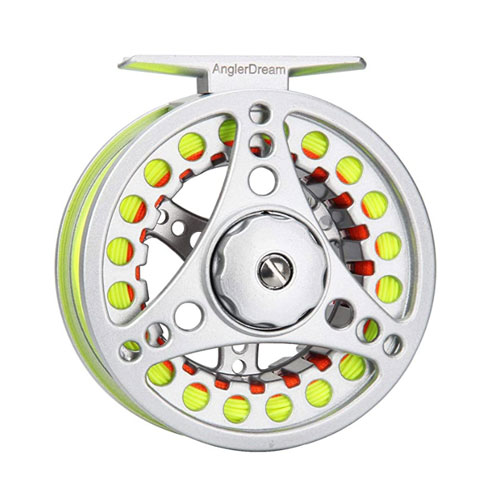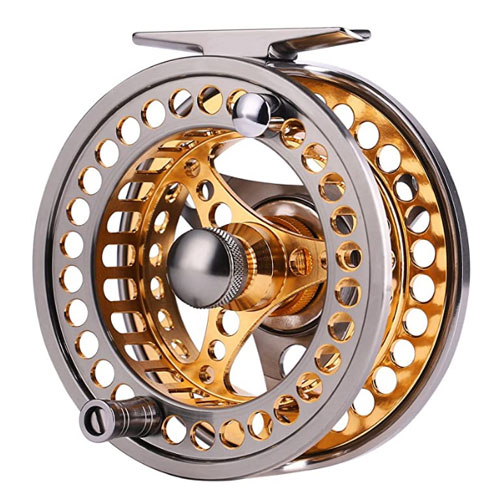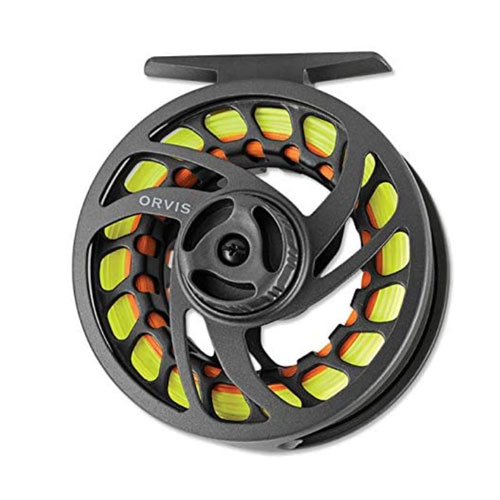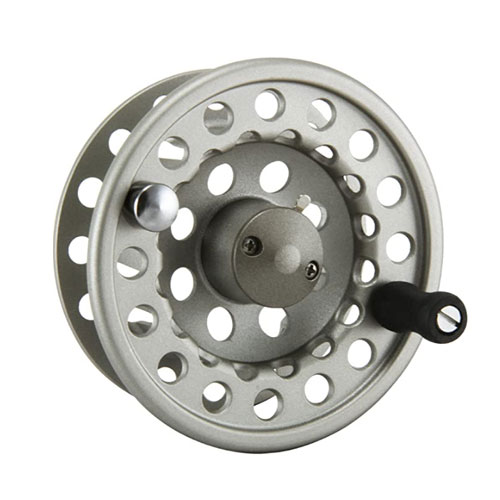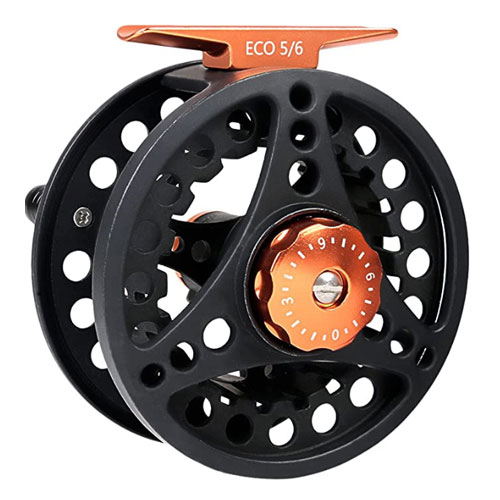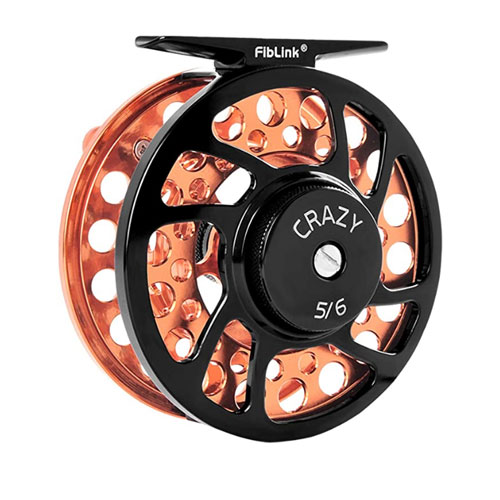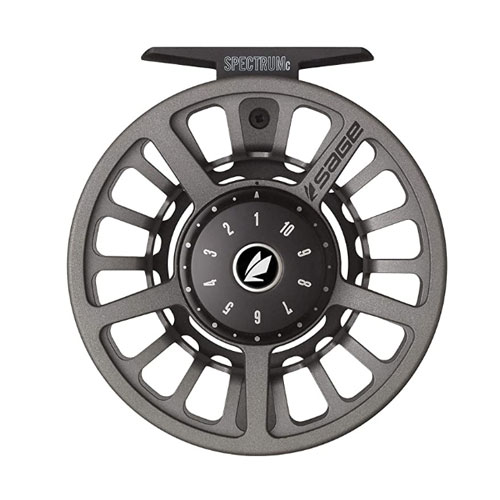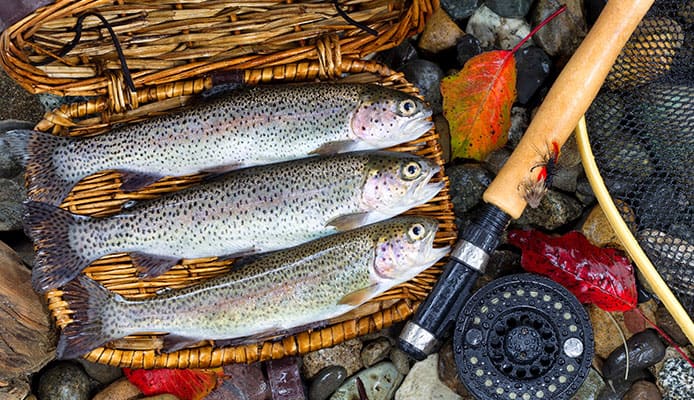
A fishing reel is a very important piece of the puzzle when assembling your fly fishing gear. Good fly reels make catching fish smoother, more enjoyable, and a lot more efficient. As you know, their job is to hold the line, release it when you cast, and reel it in when the fish takes the bait. If you hook a large, fast-swimming fish, the quality of your reel is what determines the outcome.
In this article, we’ll discuss the construction and features of fly fishing reels so you can easily find the right one to pair with your rod. In addition, we have also selected and reviewed the best fly fishing reels currently on the market which will help you tackle your catch every time.
OUR TOP PICK
Waterworks-Lamson Liquid
- Stand Out Features - Why We Love It
- Polyurethane finish provides additional protection to the reel
- Large arbor design allows the reel to hold more backing
- Sealed conical drag system makes it the best saltwater fly reel
- Available in four sizes and two great-looking color options
Sizes: 2-4 wt (3+), 4-6 wt (5+), 6-8 wt (7+), 8-10 wt (9+)
Construction: Die-Cast
Material: Aluminum with PU Coating
Weight: 0.8 pounds
Retrieve: Ambidextrous
EDITORS CHOICE
Redington Behemoth
- Stand Out Features - Why We Love It
- Large reel drag knob makes line adjustments easier
- Carbon drag mechanism combines strength and low weight
- Large arbor makes retrieving the line much faster
- Ambidextrous design with easy left-to-right conversion
Sizes: 4-5, 5-6, 7-8, 9-10, 11-12 wt
Construction: Die-Cast
Material: Carbon Fiber
Weight: 0.5 pounds
Retrieve: Ambidextrous
BEST VALUE
Piscifun Sword
- Stand Out Features - Why We Love It
- Anodized aluminum casing works great for saltwater fishing
- No deviation in the reel (only 0.04 inches of interspace)
- Stainless steel bearing improves the reel strength
- CNC-machined construction provides impressive smoothness
Sizes: 3-4, 5-6, 7-8, 9-10 wt
Construction: CNC-Machined
Material: Anodized 6061-T6 Aluminum
Weight: 4 ounces
Retrieve: Ambidextrous (Left Hand Default)
Angler Dream Large Arbor
- Stand Out Features - Why We Love It
- Durable 6061-T6 aluminum casing resists corrosion
- One-way bearing design makes reeling more secure
- Hollowed-out frame reduces weight but remains strong
- 9 feet of high-quality nylon line included in the package
Sizes: 1-2, 3-4, 5-6, 7-8 wt
Construction: Die-Cast
Material: Aluminum
Weight: 0.44 pounds
Retrieve: Ambidextrous
Sougayilang
- Stand Out Features - Why We Love It
- Immediate and smooth drag even with large fish
- CNC-machined construction for top-level precision
- Anodized surface provides additional water protection
- Fiber-composite drag system improves the performance
Sizes: 5-6, 7-8 wt
Construction: CNC-Machined
Material: 6061-T6 Aluminum
Weight: 0.33 pounds
Retrieve: Ambidextrous
Orvis Clearwater
- Stand Out Features - Why We Love It
- Powder-coated finish improves the reel durability
- Die-cast aluminum reel with impressive strength
- Available in two sizes to fit most standard line weights
- Positive click drag knob for a higher level of precision
Sizes: 4-6, 7-9 wt
Construction: Die-Cast
Material: Aluminum
Weight: 8.32 ounces
Retrieve: Ambidextrous
Okuma SLV Diecast
- Stand Out Features - Why We Love It
- Non-slip rubberized knob stays firmly in the hand
- Roller bearing allows drag in one direction only
- Left hand retrieve can easily be switched to the right
- Stainless steel drag washers improve the strength
Sizes: 8-9 wt
Construction: Die-Cast
Material: Aluminum
Weight: 0.49 pounds
Retrieve: Ambidextrous (Left Hand Default)
M Maximumcatch ECO
- Stand Out Features - Why We Love It
- Pre-loaded with a high-quality fishing line
- Polished die-cast 6061-T6 aluminum casing
- Strong disc allows you to reel in large fish
- One-year warranty with a full satisfaction guarantee
Sizes: 3-4, 5-6, 7-8 wt
Construction: Die-Cast
Material: 6061-T6 Aluminum
Reel Weight: 1 pound
Retrieve: Ambidextrous
- Stand Out Features - Why We Love It
- High-quality CNC-machined aluminum body
- 1:1 gear ratio makes reeling in very easy
- One of the lightest reels available (5.1 ounces)
- Drawstring bag included for safer transportation
Sizes: 5-6, 7-8 wt
Construction: CNC-Machined
Material: Aluminum
Reel Weight: 5.1 ounces
Retrieve: Ambidextrous
Sage Spectrum C
- Stand Out Features - Why We Love It
- Vented concave arbor picks the line up very fast
- High-performance Spectrum sealed drag mechanism
- Machined drag knob and handle for extra strength
- Four available sizes fit almost any line (3 to 10 weight)
Sizes: 3-4, 5-6, 7-8, 9-10 wt
Reel Construction: Die-Cast
Material: Aluminum
Fly Reel Weight: 10.1 ounces
Retrieve: Ambidextrous
Tip 1:
It’s very important to ensure when you’re looking to purchase a fly reel to confirm it has an adjustable drag system! I’ve made this mistake in the past, and I had no clue fly reels without adjustable drag existed. I purchased a reel in the past without noticing in the description it only had one drag setting. When I first received the reel in the mail, I thought maybe this was a cool idea and didn’t return it, but after hooking much larger fish with this reel and having them constantly pull outline without me having any control over them I really regret it. Don’t make my mistake, because you never know when you might hook a bigger fish that if you had the right drag setting may have had a better chance at landing them.
Tip 2:
When you’re shopping around for a new fly reel, if you’re new to the sport, it’s vital the weight rating of the reel you purchase matches the weight rating of the rod you’re planning on placing it on. Also, along with matching the rating of the rod and reel, make sure the fly line you purchase is either rated the same weight or one above. If the fly lines weight rating is just above the weight rating of the rod and reel, you won’t have problems turning overflies, however, going one weight rating below with the fly line can make it somewhat difficult to cast flies since the line won’t have enough power to turn over your files depending on what you’re throwing weight wise.
Tip 3:
Depending on how serious you are as a fly fisherman, you may want to purchase a high-quality fly reel you know will not let you down when you depend on it. This article does a great job explaining what separates a quality reel from a less quality reel. If you can’t afford some of the higher-end fly reels on the market no worries! If you search around on Amazon and look at the reviews for some of the cheaper priced fly reels, a good majority of the reviews are 5-star reviews and some argue the reels work just as good as high-end fly reels. The list of fly reels listed in this article includes some of these lower-priced but very dependable fly reels. Max catch, pitiful, and other companies are great alternatives to higher-priced fly reels if you can’t afford them like me as a college student.
![]()
Fisherman
How To Choose The Best Fly Fishing Reel – Buying Guide
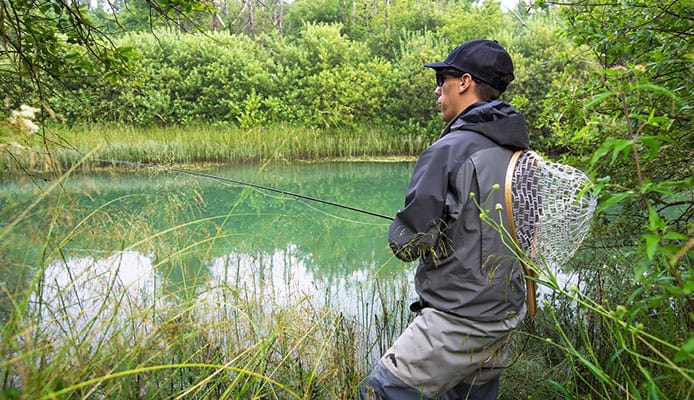
When searching for your personal best fly fishing reel, you need to consider various factors like size, construction quality, and drag system design among other things. Good fly reels need to be lightweight and user-friendly on one hand while simultaneously packing the punch to tackle big fish.
Construction
The best fly fishing reels are either CNC-machined or made using the die-casting process. Generally speaking, CNC-machined reels offer significantly higher quality, strength, and durability but, unfortunately, they also cost more. They are precisely made from a single block of aircraft-grade aluminum through a computerized process. The surface is often anodized for abrasion and corrosion resistance.
On the other hand, the manufacturing of the more affordable die-cast aluminum reels involves pouring molten metal into a pre-formed cast. While this results in decent quality, these reels are not as light, strong, or shatter-resistant as machined models.
Size and Weight
Size is a very important consideration when shopping for a fly fishing reel. First of all, you will want to ensure that the line weight capacity of your reel matches your fly fishing line and your rod. The reel size should match your target species and type of fishing. A small reel is sufficient for small fish while large, saltwater game fish demand a large reel. Last but not least, you want a reel size and weight that feels good in your hand (a lighter reel causes less fatigue).
Arbor Design
Even though all fly reels feature the same round shape, there are small differences in the details. The most important aspect to pay attention to is the arbor design. If you don’t know what this is, the arbor is the cylinder that spans from the center spindle to the base of the spool and holds the fishing line.
Standard arbor design holds plenty of backing capacity but has narrow frames so the tightly coiled line has high memory and develops coils. A mid-size arbor design has a widened reel to offer a good line capacity, reduced line coiling, and faster retrievals. Most modern models are designed as a large arbor reel that holds a lot of line and backing, offers extremely fast retrieval rate, and reduces line memory.
Drag System
The disc drag system on a fly fishing reel offers resistance to prevent fast-swimming fish from pulling all the line off the reel. If you cast flies to entice larger fish or often find yourself using your reel to fight fish, you need to ensure that you choose a reel with a powerful and smooth disc drag system. A disc drag will serve you best in this case. Keep in mind that the best saltwater fly reels need to have sealed disc drag systems to prevent corrosion and abrasion.
You might also like: Perfect Bowfishing Reels
Left or Right-Handed Operation
Since most people are right-handed (handle the fly rod with their right hand and retrieve with their left), most fly fishing reels feature knobs on the left side. However, there’s no need to worry even if you’re left-handed – all the best fly fishing reels offer easily reversible retrieve.
Line Weight And Size
Every fly reel that you’ll come across will specify the recommended weight of its fly line and backing. It’s essential to choose a model whose line weight and size rating match your rod weight. For example, if you use a 7/8 weight line, you need a 7/8 weight rod and reel should also have a 7/8 weight rating too.
Quality
Since this isn’t something you buy every day, you need to pay attention to the reel’s manufacturing quality as this ensures that it performs smoothly and lasts a long time. As we’ve pointed out, CNC-machined trout reels offer the highest level of quality but die-cast models can be very good too. In addition, quality drags and bearings are fully sealed for additional corrosion protection.
FAQs
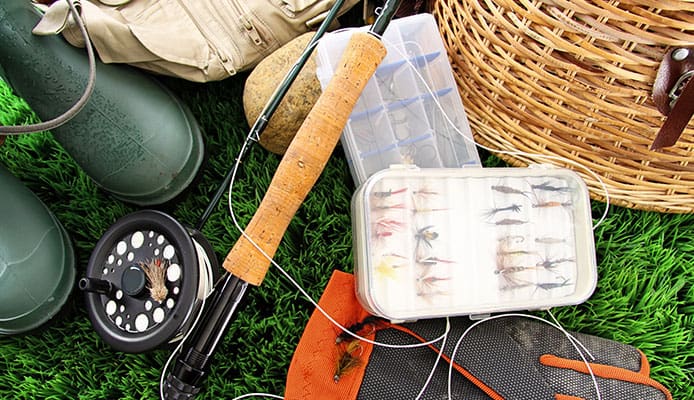
Q: What Makes a Great Saltwater Fly Reel?
The best saltwater fly reels need to have a sturdy machined aluminum construction and features such as a strong and smooth drag system, a large line capacity for handling faster and stronger saltwater fish, and a large arbor design for high-speed line retrievals. In addition, the bearings and drag system need to be fully sealed to prevent saltwater and sand from getting in.
Q: What is a Cassette Fly Reel?
A cassette fly reel is a reel with a spool frame that works with plastic spools and allows easy spool swapping. This makes it particularly convenient for various types of fly lines such as floating and sinking lines. Plastic spools are cheap and lightweight, which is why a cassette fly reel is a great choice for fly anglers on a budget and those on the go.
Q: Why Do I Need A Special Fly Fishing Reel?
You need a special fly fishing reel because of the dynamic nature of fly fishing. The best fly reel is lightweight but highly responsive and greatly increases your chances of making a catch. Besides the reel, you’ll also need a special fly fishing rod, line, and flies.
Related Reviews: Spinning Reel Under 50 & Baitcasting Reel Under 100
Q: How Do I Know What Size Fly Reel To Get?
The reel you pick should match your rod in size and be able to hold the line weight that you need. For example, reels and lines that have 3-4 weight will be great for small fish, while larger saltwater species require heavier and larger options.
Globo Surf Overview
Equipping your rod with the best fly fishing reel can make a big difference in the outcome of a fishing situation. Now that you know what you need to look for, we’re certain that you’ll make the right choice. We hope that our guide and reviews helped you in this decision so you can be ready for every fish that takes the bait.
More Fishing Reels Reviews:
- Daiwa Spinning Reels
- Salmon Reels
- Reels For Stripper Fishing
- Musky Reels
- Reels For Tuna Fishing
- Spinning Reels Under $100
- Shimano Spinning Reels
- Baitcasting Reels Under $100
- Spinning Reels Under $50
- Catfish Reels
- Underspin Reels
- Ultralight Spinning Reels
- Trout Fishing Spinning Reels
- Spinning Reel For Bass
- Surf Fishing Reels
- Crankbait Reels


